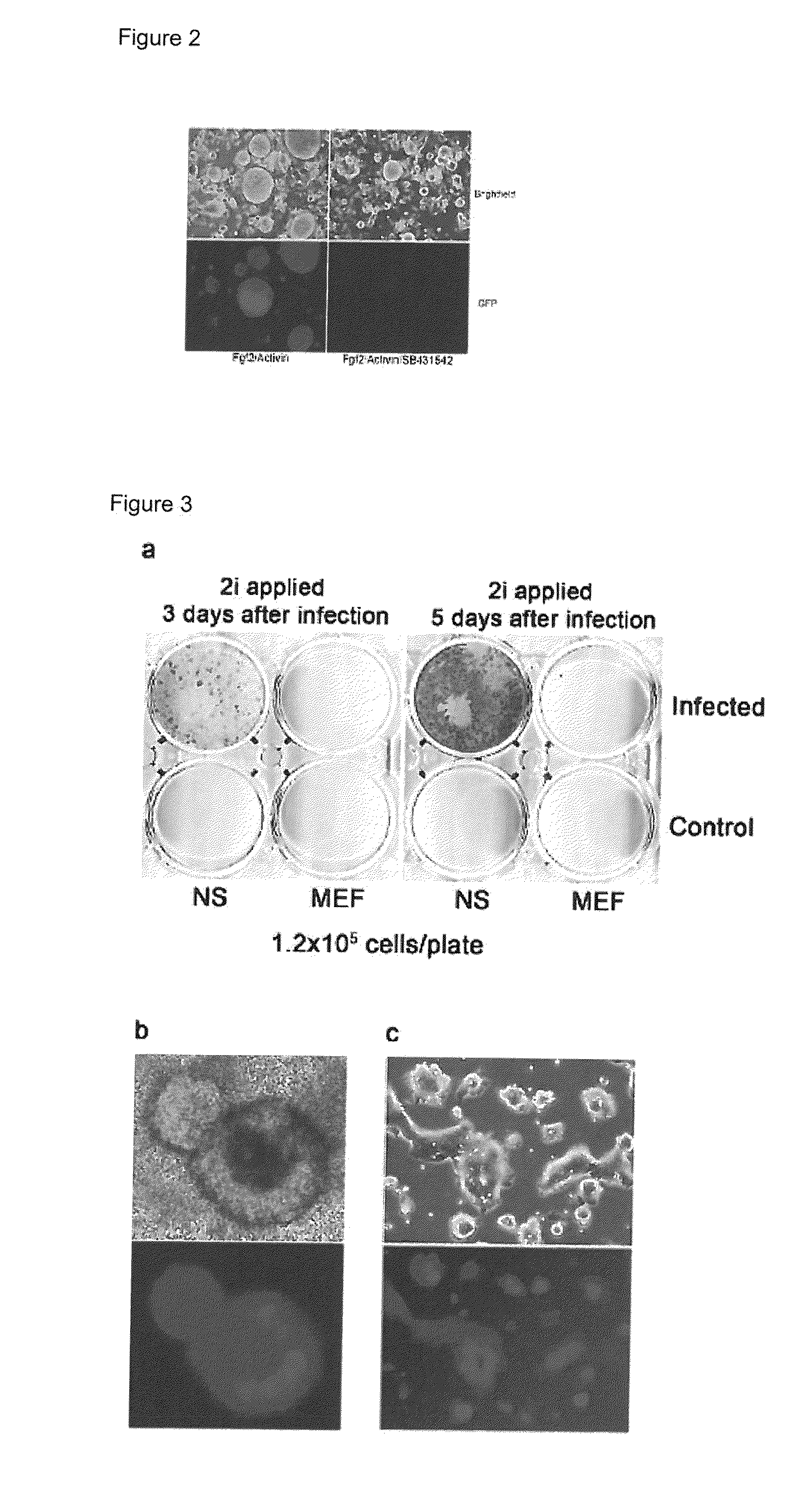Improved Reprogramming of Mammalian Cells, and Cells Obtained
a technology for reprogramming and mammalian cells, applied in the direction of skeletal/connective tissue cells, viruses/bacteriophages, peptides, etc., can solve the problems of adversely affecting the prospects of successful differentiation, reprogramming factors are continually expressed in the cell, and the complete reprogramming of human tissue cells back to pluripotent cells has not been proven. , to achieve the effect of quick reprogramming time and easy transfection
- Summary
- Abstract
- Description
- Claims
- Application Information
AI Technical Summary
Benefits of technology
Problems solved by technology
Method used
Image
Examples
example 1
Material and Methods
Mice
[0153]Target cells (NS cells and MEFs) were derived from HP165 mice, carrying regulatory sequences of the mouse Oct4 gene driving GFP and puromycin resistance.
Cell Culture
[0154]NS cells were derived from 14.5-dpc foetal forebrain (F-NS) and adult lateral ventricle (A-NS) as described elsewhere (Conti et al., 2005). NS cells were maintained in N2B27 supplemented with 10 ng / ml of both EGF and FGF-2.
[0155]Foetal NS cells were also derived from a non-transgenic C57BU6 male foetus.
[0156]MEFs were isolated from 13.5 d.p.c. embryos. After the removal of the head, visceral tissues and gonads the remaining bodies were washed in fresh PBS, minced using a scalpel and then dissociated in a 0.1 mM trypsin / 1 mM EDTA solution. Cells were collected by centrifugation (1200 rpm for 3 min) and resuspended in fresh medium. 1×106 cells (passage 1) were cultured on T-25 flask at 37° C. with 5% CO2. In this study, we used MEFs within three passages to avoid replicative senescence. ...
example 2
[0205]We modified the methods used for reprogramming of mouse NS cells for reprogramming of human adult NS cells (XX) using transient plasmid-based expression of the reprogramming factors of example 1.
Plasmid preparationPlasmidAmountVolume10 rxCAG Oct40.2μg0.09μl0.9μlCAG cMyc1μg0.26μl2.6μlCAG Klf41μg1μl10μlCAG Sox21μg0.52μl5.2μlCAG Nanog1μg0.52μl5.2μlCAG GFP1μg1μl—
Nucleofection Protocol
[0206]hNS cells were expanded on laminin using SCS RHBA media supplemented with EGF and FGF.
[0207]On the day of nucleofection:—[0208]Cells were dissociated into a single cell suspension using Accutase.[0209]8×108 cells were separated and spun at 1400 rpm for 3 min.[0210]Cells were resuspended in 400 μl of Amaxa Nucleofection Solution V.[0211]2.39 μl of mixed DNA (or 1 μl of CAG GFP plasmid) was added to the Nucleofection cuvette as well as 100 ul of the cells suspension (2×108 cells).[0212]Cuvette was placed in Nucleofector and run at T-20 program.[0213]Nucleofected cells were transferred from the cuv...
example 3
[0221]In further experiments, infection of NS cells with only 2 factors (Oct4 and cMyc) resulted in the generation of incompletely reprogrammed iPS cells (I-iPS) as with 3 or 4 factors (above). Nevertheless once these were cultured in 2i+LIF conditions numerous fully pluripotent iPS cell colonies appear with high efficiency (as demonstrated by GFP reporter expression—see above).
[0222]In other 2-factor experiments, Oct4 and Klf4 I-iPS colony appearance was delayed (2 weeks for colony appearance). However, when 2i+LIF was applied directly (without culture on feeder) a number of GFP colonies appeared.
[0223]The results are shown in FIG. 11.
PUM
| Property | Measurement | Unit |
|---|---|---|
| Fraction | aaaaa | aaaaa |
| Fraction | aaaaa | aaaaa |
| Fraction | aaaaa | aaaaa |
Abstract
Description
Claims
Application Information
 Login to View More
Login to View More - R&D
- Intellectual Property
- Life Sciences
- Materials
- Tech Scout
- Unparalleled Data Quality
- Higher Quality Content
- 60% Fewer Hallucinations
Browse by: Latest US Patents, China's latest patents, Technical Efficacy Thesaurus, Application Domain, Technology Topic, Popular Technical Reports.
© 2025 PatSnap. All rights reserved.Legal|Privacy policy|Modern Slavery Act Transparency Statement|Sitemap|About US| Contact US: help@patsnap.com



